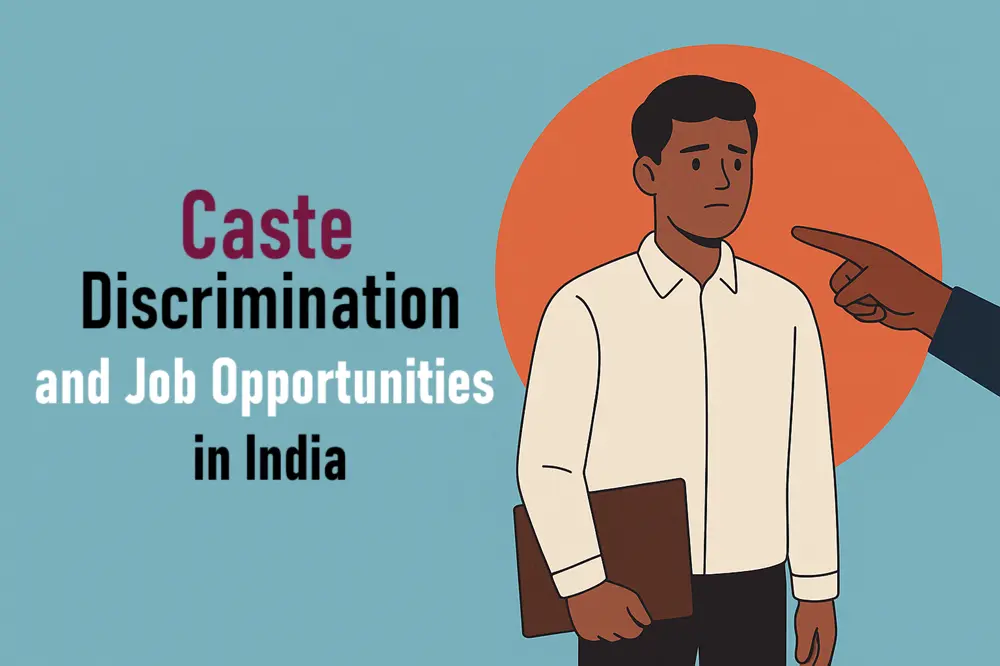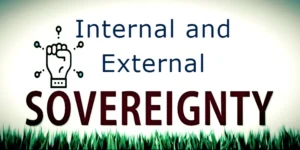Caste has shaped India’s social and economic life for centuries, and its impact is still visible in today’s job market.
Even with growth, modern industries, and new opportunities, many people still face invisible walls because of their caste identity. This affects who gets called for an interview, what kind of job they land, how much they earn, and how far they can rise.
Studies show that caste can limit access to secure, well-paying roles, even for equally qualified candidates. It’s not just about fairness—it’s also about lost talent and missed economic growth.
In this article, we’ll explore the latest data, research, and real-world examples to understand how caste discrimination continues to shape job opportunities in India.

How Does Caste Discrimination Affect Job Opportunities in India? Facts, Figures and Solutions
Caste discrimination remains a deeply entrenched social issue in India, influencing not only interpersonal dynamics but also access to economic opportunities.
Despite constitutional safeguards and affirmative action policies, marginalized communities—especially Scheduled Castes (SCs) and Scheduled Tribes (STs)—continue to face systemic barriers in the labor market.
Understand how caste-based discrimination shapes hiring, wages, and career growth in India. Learn about its impact on marginalized communities and the challenges to achieving workplace equality. Explore latest data, research, and solutions for equal job opportunities.
Key takeaways (for quick answers)
- Access to good jobs still varies by caste—SC/ST workers are more likely to be in casual or informal work and earn less on average than “Others,” even when education is similar.
- Hiring bias exists in parts of the private sector (resume/correspondence experiments using caste-signaling names show lower callback rates), though effects vary by occupation.
- Unemployment has fallen nationally, but gaps by social group and, more importantly, by job quality persist (regular salaried, formal jobs).
- Representation at the top is skewed—research finds severe under-representation of lower castes in corporate leadership; new commentary links greater caste diversity on boards with stronger social performance.
- Most private employers do not have caste-sensitive DEI, even as experts now urge “Indianizing” diversity programs to include caste.
What do we mean by “caste discrimination in jobs”?
The Indian caste system is a closed social stratification system in which people inherit their positions and have little mobility.
Caste discrimination in employment refers to unequal treatment before, during, and after hiring because of a person’s caste identity (often proxied by last name, village, schooling, language, or networks).
Caste discrimination in employment can appear at three levels: (1) access (who gets interviewed/called back), (2) assignment (who is funneled into low-status or informal roles), and (3) advancement (who gets training, promotions, or leadership roles).
Classic Indian labour-market studies, including those published in Economic & Political Weekly, locate caste as a persistent system of stratification that misallocates talent and depresses aggregate productivity—because people are filtered by identity rather than skills.
This view treats caste bias as not just a moral issue but an economic inefficiency that blunts human-capital returns and reduces overall growth.
In modern workplaces, discrimination can be overt (slurs, exclusion from client-facing roles) or covert (algorithmic screening that mirrors biased networks, “culture fit” codes that track caste).
Global management scholarship now flags caste as a material workplace risk—affecting well-being, retention, collaboration, and even legal exposure—especially in firms with South Asian talent pipelines.
If caste shapes who gets interviewed, trained, or trusted, it affects job opportunities in ways that can be measured in data on hiring, earnings, and leadership.
Read Here: The Impact of Social Stratification on Our Society
What the latest official data says: employment and unemployment by social group
India’s Periodic Labour Force Survey (PLFS) is the government’s flagship jobs dataset. The 2022–23 annual report shows national unemployment continuing to decline (male UR 3.3%, female 2.9% on usual-status basis), and subsequent 2023–24 tables keep that trend broadly intact.
But unemployment alone does not capture who gets quality jobs. Disaggregated PLFS tables by social group (SC, ST, OBC, Others) consistently show lower participation in regular salaried work and higher concentration in casual self-employment among SC/ST, particularly in rural areas.
The reduction in overall UR thus coexists with stratification in job types that matter for security and earnings.
Media summaries of the latest PLFS rounds also report mixed but small changes in UR across social groups (for example, SC unemployment easing from 4.4% to ~3.3% between 2021–22 and 2023–24), affirming that headline improvements do not automatically translate into equal access to better work.
Because PLFS is representative and updated annually, it remains the baseline for tracking social-group outcomes—but serious analysts pair it with research on quality of employment (formalization, contracts, benefits) to see how caste identity maps onto opportunity gradients in the labour market.
While 2024–25 PLFS data are available for many indicators, they are not broken down by social groups (SC, ST, OBC, Others). This disaggregation was available in earlier rounds up to 2022–23, but is not included in the publicly released 2024–25 bulletins or press materials.
Most recent analyses of caste-wise disparities still rely on the 2022–23 annual report.
In April 2025, India’s unemployment rate stood at 5.1%: 4.5% in rural areas, and 6.5% in urban areas.
In May 2025, rural unemployment fell, urban remained elevated, and overall UR rose to 5.6%.
In June 2025, the unemployment rate stayed steady at 5.6%. However, rural unemployment decreased to 4.9%, while urban unemployment climbed to 7.1%.
Youth unemployment worsened: urban youth (15–29 years) faced 18.8% UR, up from 17.2% in April; rural youth UR rose to 13.8%.
Beyond jobs to good jobs: The quality and earnings gap
The State of Working India 2023 (Azim Premji University) synthesizes PLFS microdata to look past headcounts and into job quality. Two findings stand out.
First, social identity correlates strongly with the type of work—SC/ST workers are more likely to be in casual and informal roles with lower security.
Second, the earnings gap is large: the report documents that regular salaried earnings of SC/ST workers are about three-quarters of those of “Others”, and gaps are even starker in self-employment.
These differentials persist even after controlling for education and location, which suggests structural disadvantages, networking effects, and discrimination—not just skill differences.
The same report tracks intergenerational mobility and shows some improvement—but less so for SC/ST.
For sons of casual workers, the probability of remaining in casual work fell for all groups from 2004 to 2018, but remained much higher for SC/ST (86%→76%) than for non-SC/ST (83%→53%). That is, escape routes out of precarious work are narrower for historically disadvantaged castes.
In practical terms, caste continues to shape the ladders and the ceilings in India’s labour market.
Hiring bias in practice: Evidence from resume and field experiments
To isolate discrimination at the entry gate, researchers run correspondence experiments—sending identical CVs that differ only in a caste-signaling marker (like a surname).
A landmark study in Delhi found lower callback rates for non-upper-caste applicants in several occupations, evidence of statistical or taste-based bias.
While one sector-specific paper reported no detectable bias in software jobs, the broader takeaway is that hiring discrimination exists but is heterogeneous—stronger in some roles and weaker where evaluation relies on verifiable technical tests.
Global meta-analyses of correspondence experiments also confirm that identity-based unequal treatment remains common across countries despite formal anti-discrimination norms.
Why does this matter for job opportunities? Because callbacks unlock interviews, and interviews unlock the pipeline to salaried employment.
Even a 5–10% callback penalty compounds over multiple applications, delaying or derailing entry into formal work. It also channels candidates toward sectors that rely more on informal contacts and less on competitive testing, amplifying segregation over time.
The policy implication is straightforward: reduce identity cues at screening (structured forms, anonymized resumes) and standardize assessments to level the first gate.
Urban corporate ladders and the leadership gap
Access is one thing; authority is another. Research mapping the caste composition of India’s corporate leadership has repeatedly found heavy over-representation of “forward” castes among CEOs and directors, and near-zero caste diversity on boards in samples of large listed firms—starkly misaligned with population shares.
Although precise caste disclosure is rare (firms do not report it), triangulation using surnames and public bios indicates that 94% of CEOs in large samples belong to a narrow set of upper-caste groups.
More recent commentary in EPW argues that greater caste diversity on boards is associated with stronger human-rights and CSR scores, suggesting a governance and performance upside to inclusion.
At the policy level, Indian securities regulation currently mandates gender diversity on boards, which helped lift women’s representation to ~21% in top-200 NSE companies by 2024—but no such mandate exists for caste, and most firms do not track it.
That has left caste largely off-limits in corporate DEI, according to business journalism and consulting analyses, even as India’s workforce remains caste-stratified. This measurement gap makes progress hard to manage—and harder to prove.
Public vs private: Reservations, reach, and the “missing” ladder
India’s Constitution bans untouchability and prohibits caste discrimination, and the country operates one of the world’s largest affirmative action systems (“reservations”) for SC/ST and OBCs in public-sector jobs and education. However, private-sector employment is not covered by comparable quotas.
As the economy’s centre of gravity has shifted toward private services and manufacturing, many of the best-paying roles sit outside the reservation net.
Multiple labour-market reviews note that this institutional asymmetry helps explain why SC/ST workers remain under-represented in high-authority private roles despite public-sector gains—a classic case of policy reach not matching labour-market structure.
Business press now reports growing debate on whether DEI frameworks should explicitly include caste alongside gender and disability.
Practically, this means the fastest-growing ladders—corporate tech, finance, modern services—are governed by firm-level norms rather than quotas.
Where firms adopt equal-opportunity policies, transparent hiring rubrics, and bias-aware HR, gaps can narrow.
Where they don’t, informal networks and credential signaling (colleges, internships) can reproduce old hierarchies in new industries.
Geography and sector: Where gaps are widest
Caste disparities are not uniform. Using PLFS and secondary analyses, researchers find rural labour markets show higher caste-linked exclusion from regular salaried work than urban markets, and certain sectors (construction, sanitation, low-end services) remain heavily segregated.
Oxfam’s discrimination report, reading across PLFS years, highlights that access to regular salaried jobs is especially constrained for marginalized caste groups in rural areas.
Urban growth has opened doors in modern services, but entry barriers remain where hiring runs through referrals and informal brokers.
Even in cities, the informal-formal divide mirrors caste lines: SC/ST workers cluster in informal and semi-formal roles with limited social security.
Meanwhile, the export-facing software sector—where tests and coding challenges dominate screening—shows smaller measured bias at entry, though not necessarily in advancement or team dynamics.
Bottom line: sectoral hiring technology matters—the more hiring relies on standardized, skill-verified evaluation, the less room for identity to sway outcomes.
Intersectionality: Why Dalit women face a “double gap”
Gender and caste compound. Oxfam’s employment analyses (and earlier syntheses) document that Dalit women face “double discrimination”—by gender and caste—steering many into hazardous, stigmatized, or highly informal work.
State of Working India adds a numeric lens: women’s earnings in salaried work average ~76% of men’s, and SC/ST earnings show a similar 76% ratio versus “Others,” implying especially large penalties for Dalit women in both pay and job quality.
Intersectional disadvantage shows up in lower hiring rates, narrower occupational tracks, and higher exit rates after childbirth when informal contracts provide no protection.
Tackling opportunity gaps, therefore, demands joined-up policy on gender and caste, not one at a time.
Why this hurts the economy (not just individuals)
From an efficiency angle, discrimination misallocates human capital. When equally skilled candidates are sorted by identity, firms risk lower productivity, fragile cultures, and missed innovation.
Foundational EPW work framed caste discrimination as a drag on India’s growth, reducing competition for good jobs and wasting talent.
Contemporary management research echoes this: unchecked identity bias weakens information flows, collaboration, and market reach.
New commentary even ties caste-diverse boards to better social-performance metrics, hinting at a business case for inclusion alongside rights and equity.
The upshot is clear: reducing caste barriers is not only fair, it is profitable for firms and growth-enhancing for the economy.
What companies are (and aren’t) doing—and why it matters
Despite progress on gender mandates (women now comprise roughly one-fifth of directors in top-200 NSE companies), business reporting finds that caste remains off-limits in many corporate DEI programs.
Without measurement, there is little management: firms seldom collect caste data, rarely audit hiring pipelines or pay equity by social group, and almost never set targets.
Experts now urge companies to “Indianize” DEI, for example by:
- adopting equal-opportunity policies that explicitly include caste,
- ensuring anonymized screening and structured interviews,
- running pay-gap audits by social identity, and
- expanding mentor/sponsorship and supplier diversity to include SC/ST-owned enterprises.
These are not radical steps; they mirror global good practice adapted to India’s realities.
The business press and management journals warn that ignoring caste can expose firms to reputational and legal risk and undermine talent outcomes.
Policy tools that move the needle
Public policy already provides reservations in government jobs and higher education, which have raised representation and built human capital among SC/ST and OBC groups.
But because most new, high-wage jobs are private, complementary tools matter:
- Transparent recruitment in public contracting (requiring vendors to adopt equal-opportunity and non-discrimination clauses).
- Skills + placement programs that pair training with bias-aware hiring and interview coaching.
- Stronger enforcement of existing anti-discrimination provisions and grievance redress.
- Data infrastructure: encouraging voluntary, privacy-safe caste tracking to monitor progress (as firms already do with gender).
International evidence suggests system-level (“s-frame”) interventions outperform one-off trainings: change structures (job ads, screening, interviews, audits), not just minds.
Caste Discrimination in Jobs: Key Statistics and Trends at a Glance
Look at the most recent data, revealing persistent caste-based gaps in employment quality, earnings, leadership roles, and hiring practices.
- Unemployment (headline) has declined since 2017–18, per PLFS, yet social-group disparities in job type and earnings endure.
- Earnings gap: Among regular wage workers, SC/ST earn ~76% of “Others” on average; gaps are wider in self-employment.
- Hiring bias: Resume experiments find lower callbacks for caste-signaling names in several occupations; effects may be smaller in software roles, indicating heterogeneity.
- Leadership skew: Studies report near-zero caste diversity on boards and overwhelming upper-caste dominance among CEOs in large samples; newer commentary links board caste diversity with better social scores.
- Corporate DEI gap: Business coverage shows caste still largely absent from corporate diversity agendas, unlike gender.
What employers can do tomorrow (a practical checklist)
- Write caste-neutral job ads: ban exclusionary phrases; use plain, skill-first language; publish salary bands.
- Anonymize screening: hide names, colleges, and addresses at the first pass; rely on work-sample tests.
- Structure interviews: same questions, scored rubrics, multiple assessors; keep a paper trail.
- Track outcomes: voluntarily measure hiring, promotion, and pay by social group with privacy safeguards.
- Open the pipeline: partner with state universities, community colleges, and reservation beneficiaries for internships.
- Mentor and sponsor: formal programs to accelerate SC/ST advancement into P&L roles.
- Board-level oversight: include caste in risk and ESG dashboards; consider caste diversity alongside gender.
These steps reflect what management research and press coverage now recommend for Indian firms navigating talent and ESG.
Frequently asked questions (FAQs)
Q1. If unemployment is falling, is caste discrimination still a problem?
Yes. Falling unemployment can coexist with persistent gaps in who gets formal, salaried, and leadership roles—and in how much they earn. PLFS shows the headline improvement; research shows quality and pay gaps by caste remain.
Q2. Isn’t education the main driver?
Education helps, but doesn’t erase the gap. Even among similarly educated workers, SC/ST earn less and are under-represented in better-quality jobs, pointing to networks, occupational segregation, and bias.
Q3. Is bias measurable?
Yes. Correspondence experiments using caste-signaling names detect lower callback rates for some groups, though results vary by sector (smaller in software roles).
Q4. What’s new in 2023–24 PLFS rounds?
The national UR continued to edge down, but analysts emphasize job quality and earnings—where social-group disparities persist.
Q5. Why bring caste into corporate DEI?
Because most new high-wage jobs are private, and ignoring caste misses a core Indian reality. Business reporting shows caste is still largely absent from DEI; experts advise explicit inclusion to reduce risk and unlock talent.
Q6. Do caste gaps still exist in government jobs?
Yes, but they are narrower than in the private sector. Reservations for SC, ST, and OBC have increased representation in many government departments, but promotion bottlenecks and under-representation in top grades remain. The bigger challenge is that the share of public-sector jobs in total employment has shrunk, so gains here do not offset private-sector exclusion.
Q7. How does informal work link to caste discrimination?
SC and ST workers are over-represented in casual and informal jobs, which lack contracts, benefits, and social security. This is partly historical (landlessness, occupational segregation) and partly structural—informal work is easier to enter but harder to escape, locking workers into low-pay traps.
Q8. Are urban jobs free from caste bias?
No. While urban labour markets offer more skill-based hiring and anonymity, caste bias still appears through referral networks, college recruitment filters, and subtle workplace exclusion. Research shows SC/ST representation in urban regular salaried jobs is higher than in rural areas but still below population share.
Q9. Does the gig economy help level the playing field?
Partially. Gig platforms often use algorithmic matching, which can reduce human bias at entry, but caste-linked disadvantages persist through asset access (smartphones, vehicles), geographic location, and rating systems that can reflect bias from customers.
Q10. What role does education quality play?
Educational attainment is improving across castes, but quality gaps—in school infrastructure, teacher access, language, and peer networks—mean that SC/ST graduates often lack the same placement and internship pipelines as their upper-caste peers. Even with degrees, this can limit entry into high-paying sectors.
The bottom line
Caste still shapes who gets a foot in the door, what kind of job they get, how much they earn, and how far they advance.
The data are unambiguous: even as unemployment falls, quality gaps and leadership skew remain.
The strongest fixes are structural: anonymized, skill-first hiring; transparent pay and promotion; data-driven audits; and board-level accountability that treats caste the way India already treats gender in governance.
That mix isn’t just ethical—it’s economically rational and ESG-smart.





